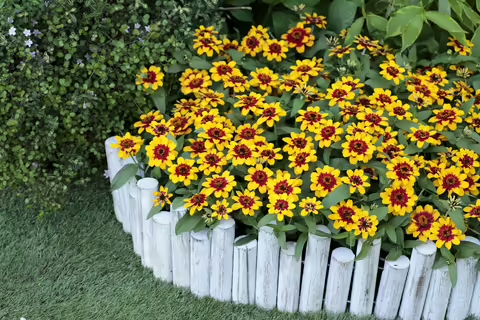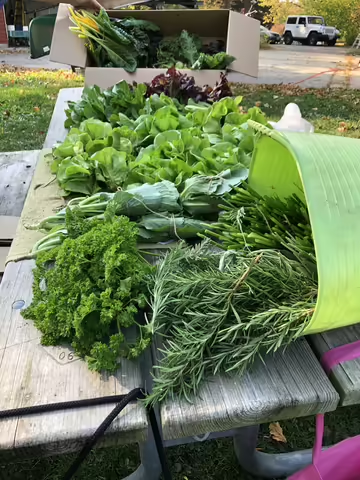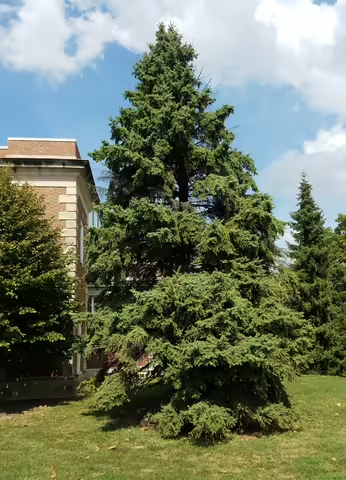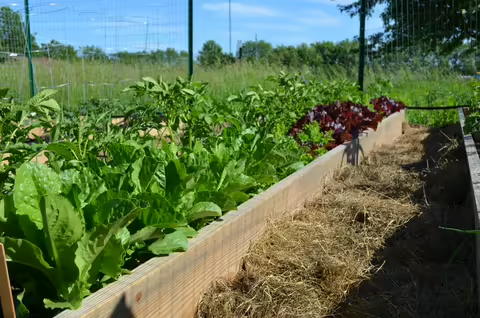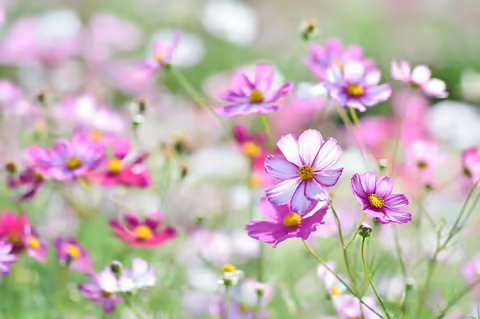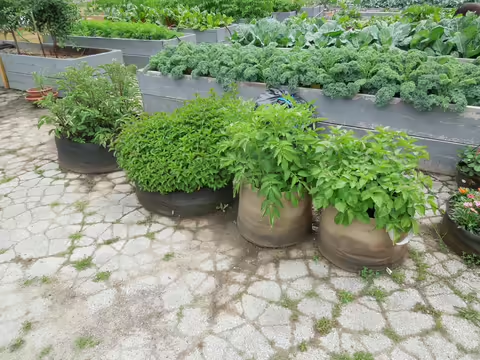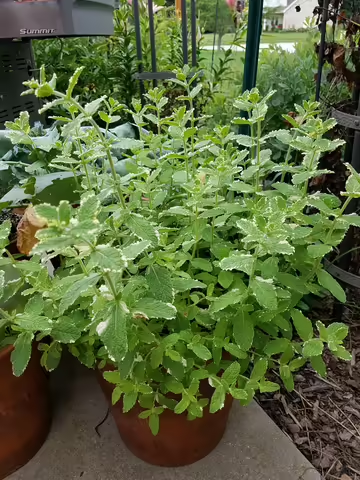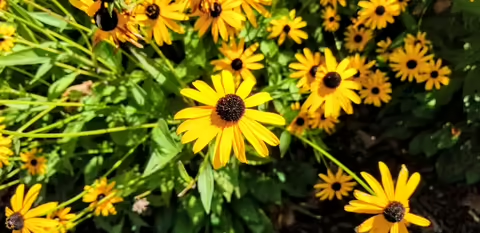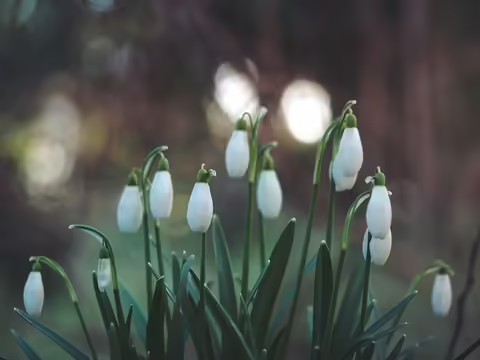Make way for 2021 award-winning All-America Selections plants
By Bruce J. Black, Horticulture Educator, Illinois Extension
Ice and snow. Ice and snow. Fluctuating temperatures and unusual warmer weather delayed this winter, but ice and snow did eventually arrive. After a long winter, we are all looking forward to spring 2021, fresh air and gardening.
While we are just now able to start seeds in March, thumbing through the 2021 seed and plant catalogs has hopefully brought you inspiration and warmth this winter.
Gardening starts long before the first seed is planted and planning is essential for both first-time and experienced gardeners.
Finding space for new plants that are suited for your USDA hardiness and having blossoms all year long can be a challenge. After mapping out your existing perennials, think about what new plants could be added to your landscape.
A great starting place is the All-America Selections, AAS, an independent non-profit organization that releases several trialed plants each year as AAS Winners. New, never-before-sold varieties are tested every year at the AAS private and public trial sites around the United States and Canada. There are four trial locations in Illinois - three northern, and one central.
Independent judges who are professional horticulturists volunteer to evaluate trial entries against comparison plants and the top performers are chosen as winners. For the best plants suited to Illinois, look for Great Lakes or National winners on the AAS lists.
2021 AAS Winners
This year, there are six AAS winners and five are suited for Illinois - three vegetables and two flowers.
- Echalion, Creme Brulee (Allium cepa var. Creme Brulee F1): This is the first shallot to ever be awarded the AAS Winner designation. Grown from a seed, this is a sweet tender bulb that is easy to peel and matures earlier than other shallots with only 98 days to harvest. Regional Great Lakes Vegetable Winner.
- Pepper, Pot-a-peno (Capsicum annuum var. Pot-a-peno): A compact, early maturing jalapeno perfect for containers. This green jalapeno changes to red for a sweet, spicy flavor. Time to mature is 45 to 50 days for green fruit and 60 to 65 days for red fruit. Regional Great Lakes Vegetable Winner.
- Squash, Goldilocks F1 (Cucurbita pepo var. Goldilocks): This acorn squash is vigorous, high yielding and disease tolerant. Bright orange with a rich nutty flavor and uniform shape it can be harvested in 70 to 85 days. National Vegetable Winner.
- Celosia, Kelos® Candela Pink (Celosia spicata var. Candela Pink): Like a tapered candle with showy pink plumes that keep color all season, this annual is 25- to 30-inches tall. Feed and water regularly for continued beauty. Regional Great Lakes Flower Winner.
- Zinnia, Profusion Red Yellow Bicolor (Zinnia hybrida var. Profusion Red Yellow Bicolor): This annual flower blossoms with a bold red center encircled by golden petals. As the season goes on, the colors soften into shades of apricot, salmon and rose. Compact at 8- to 14-inches tall and beautiful all season long. Great for a hanging basket or edging. Gold Medal Winner.
But don’t just stop with the 2021 winners. All-America Selections keeps a list of all past vegetables and flowers winners since its founding in 1933 on their website, all-americaselections.org.
For more information about gardening, check out the Illinois Extension website Watch Your Garden Grow at extension.illinois.edu/veggies/index or Illinois Extension Horticulture YouTube Channel go.illinois.edu/UniversityOfIllinoisExtensionHorticulture.
Gardener's Corner is a quarterly newsletter from the Illinois Extension team of horticulture experts. Each issue highlights best practices that will make your houseplants, landscape or garden shine in any season.
How will you grow? Join the Gardener’s Corner email list and get direct access to timely tips!
Gardening benefits body, mind, wallet
By Martha A. Smith, Horticulture Educator, Illinois Extension
A continuously connected lifestyle can drain internal batteries quickly, but digging into the world outside may be the best way to rejuvenate, revitalize and recharge.
The gadgets of gardening aren’t flashy: a shovel, pruners, hoses and bags of seeds. All are simple yet practical, and useful but not at all high-tech.
Gardener responses to a National Garden Bureau survey about why they garden hailed the health, economic, and social benefits of gardening. They also extolled the many joys found in working the land. With so many advantages to gardening, it’s not surprising the top 10 reasons are so diverse.
Garden to produce safe, healthy food
Consumers are increasingly aware of food-borne illnesses, food contamination, and the additives and preservatives found in processed food. This, coupled with interest in organic gardening, has increased the availability of organic produce.
Working out(side)
Studies show that an hour of moderate gardening can burn up to 300 calories for women and almost 400 calories for men, Mowing the grass mimics a vigorous walk. Planting requires bending and stretching, just like an exercise class. There are also devices that can help people with physical limitations enjoy the advantages of working in their garden. More information is available at go.illinois.edu/4seasonsAdaptive.
A thing of beauty
A well-tended garden enhances any setting of any size, and provides a pleasurable vista, and trees and shrubs provide color and shade, as well as shelter for birds and wildlife. More information about small space gardening is available at go.illinois.edu/SmallSpaceGardens.
Garden to learn
Gardening helps individuals learn by doing while building knowledge, gardening expertise and problem-solving skills. Gardeners find that the more they learn, the more they want to know.
Garden to earn
The love of plants can lead to anything from a job at a local garden center to owning a landscape business. Gardeners also can sell their products at local farmers markets or craft show, and landscaping projects can increase property values by up to 15%.
Sharing knowledge, broadening horizons
Gardeners love to share their gardens and their knowledge, thus expanding their social circle. Even during a pandemic, meetups with other gardeners can take place in socially distanced environments or online, and provides a way to gather information, ask questions and get involved.
Tapping into creativity
For many, gardening is an outlet for inspiration and artistic expression. Attention to design can produce everything from the serene, contemplative mood of a Japanese garden to the romantic feel of an English cottage.
Gardening to win
If you’ve got a competitive streak, gardening may be a friendly way to show off your skills. County and state fairs provide opportunities for adults and children to show off their skills as they grow giant pumpkins, beautiful bountiful beans or the perfect zinnia.
Benefits to emotional health
Gardens play an important part in our wellbeing. A garden may serve as a tranquil retreat or private escape from the demands of your daily life. A healthy harvest provides a sense of achievement and feelings of success. Gardening builds confidence and self-esteem.
Grow lasting memories
Gardening is an intergenerational activity that’s appropriate for all ages. Memories of your garden and gardening with you may help motivate young horticulturists to become the master gardeners of tomorrow. Find ideas about cultivating the next generation of gardeners at go.illinois.edu/GardeningWithKids. Each year, as they harvest their own crops, they’ll recall the sweetness of your cherry tomatoes or the beauty of the hydrangeas that you cultivated together.
That’s one of greatest gifts that a garden can give.
Gardener's Corner is a quarterly newsletter from the Illinois Extension team of horticulture experts. Each issue highlights best practices that will make your houseplants, landscape or garden shine in any season.
How will you grow? Join the Gardener’s Corner email list and get direct access to timely tips!
Tips for starting your spring garden off strong
By Ron Wolford, Horticulture Educator, Illinois Extension
Cloudy, cold winter days may seem endless, but as the weather warms, bulbs will bloom and grass will green, giving way to sure signs of spring.
Grab your trowel and get ready. Spring is just days away.
Starting seeds
Keep in mind how last year the pandemic saw new gardeners flood garden centers and increase demand for products sold by online seed companies. Buy your summer-flowering bulbs, seeds and transplants early. Last year, many seeds and transplants were in short supply or out of stock. This spring, order your seeds early and purchase your transplants as soon as they are available.
It’s also important to avoid damping-off disease when starting seeds. Damping-off will cause seedlings to wilt and die. Use a pasteurized soil-less medium. Keep the temperature around 65 to70 degrees Fahrenheit for best germination and provide bottom heat if possible. Most of all, avoid overwatering.
Soil preparation
Prepare the soil before planting. This means removing rocks and debris form the soil. Dig in a 2- to 4- inch layer of organic matter, which helps to breakdown heavy clay soils and improves drainage.
Never work your soil when it is wet. Tilling or digging when the soil is wet will cause it to dry into concrete-like clods.
Pick up a handful of soil before digging and squeeze. If it crumbles easily, it is ready to be dug. If it doesn't, it is too wet. Allow the soil to dry for a couple of more days and test again before digging.
Late spring frosts
Be prepared for late spring frosts. Cover tender plants with row covers, cardboard, blankets, hot caps, or newspaper. Do not use metal or plastic for protection, because these can conduct cold to plants.
We have had frost close to Memorial Day in Illinois. The latest spring frost occurred in Rockford on May 27, 1992.
The growing season between the last spring frost and the first fall frost ranges from around 160 days to 190 days from northern to southern Illinois.
Transplanting
Buy healthy transplants. Leaves and stems should be green and healthy without any signs of yellowing or browning. Gently remove transplants from their pot and check the root system. Roots should be white with visible soil. Check for insects such as whiteflies or aphids.
Harden off transplants. Before exposing transplants to cool, spring temperatures, wind and sun, gradually introduce them to the outdoor environment over a 10-to-14-day period. At first, place the transplants in a shaded area for a couple of hours. Gradually increase their exposure to sunlight each day until they are outdoors for 24 to 48 hours before planting.
Perennials and ornamentals
Divide perennials. Dig around the plant and lift the clump out of the ground. Break the clump into sections. Larger sections will re-establish quicker than smaller sections. Keep the clumps moist until ready to plant.
Cut back. Cut back ornamental grasses to about 4 to 6 inches. Not removing the foliage will delay the warming of the crown of the plant and will slow new growth. Ornamental grasses should be divided in the spring if the center of the plant has died out or if it has become overgrown.
For more information on bulbs, perennials, seeds or transplants, check out these Illinois Extension resources:
- go.illinois.edu/BulbInfo
- go.illinois.edu/Perennials
- go.illinois.edu/StartingSeeds
- go.illinois.edu/GrowTransplants
Gardener’s Corner is a quarterly newsletter from the Illinois Extension team of horticulture experts. Each issue highlights best practices that will make your houseplants, landscape or garden shine in any season.
How will you grow? Join the Gardener’s Corner email list and get direct access to timely tips!
The time is right to plant cool season vegetables
By Nancy Kreith, Horticulture Educator, Illinois Extension
It may seem too early to think about the harvest, but across Illinois, gardeners are anticipating the time that they can get ever-popular vegetables like broccoli, onion, and kale into the ground.
These and other hardy vegetables can be planted as soon as the ground can be worked. Typically, this occurs from mid-March to early April. Less frost tolerant vegetables can be planted soon after.
Gardeners should schedule their planting dates based on crop hardiness and days to maturity. Hardy vegetables can be planted in the spring, four to six weeks before the average frost-free date (32 degrees Fahrenheit.). Half-hardy or frost tolerant vegetables can be planted two to three weeks before spring’s frost-free date. Some vegetables that are quicker to mature can also be planted in late summer for a fall harvest.
Keep in mind that frost-free dates are averages. Actual dates will vary each year. Growers can provide additional protection by planting one to two weeks later in the spring to avoid late season frost. In the fall, plant one to two weeks early for protection against an early frost. You can also cover plants to protect against early or late season frost.
The Illinois State Water Survey has information about your local spring and fall frost-free dates
Hardy vegetables
Hardy vegetables can be planted four to six weeks before the average frost-free date, or 32 degrees Fahrenheit. A few can be planted again in late August to early September for a successful fall harvest.
- Broccoli*
- Brussels Sprouts
- Cabbage*
- Garlic* (best planted in fall)
- Kale*
- Kohlrabi*
- Leek*
- Onion
- Pea
- Rutabaga* (needs 100 days)
- Spinach*
- Turnip*
*Can be planted for fall harvest.
Half-hardy vegetables
In Illinois, half-hardy vegetables can typically be planted from late-March to early May. Most of these crops can be planted again in mid-July to early September. Potato and parsnip are the exception, and best planted in the spring.
- Beet
- Carrot
- Cauliflower
- Chinese Cabbage
- Lettuce, leaf
- Mustard
- Parsnip
- Potato
- Radish
- Swiss Chard
In addition to knowing when to plant these vegetables, it’s important to know how to select, plant and harvest them. Root crops, broccoli, and leafy greens each require special consideration.
Root crops
Root crops require well-drained soil with plenty of organic matter. Directly sow seeds 1/4 to 1/2 inch deep. Prepare a shallow trench/row and spread a pinch of seed along the row. Once seedlings are 1 or 2 inches tall, thin them to the correct spacing, typically 1 to 4 inches apart, depending on the vegetable. Harvest by pulling the plants from the ground and trimming off the tops when necessary. Beet tops can be eaten along with the sprouts that were thinned out.
Brassica (Broccoli-family crops)
Plant by direct seeding or by using transplants. Transplants are preferred with many Brassica crops as they establish faster and mature earlier. Harvest these crops at the right time based on the edible part of the plant by following instructions on the seed packet or plant label. For broccoli, cabbage, and cauliflower, harvest once head forms. Timing is essential because vegetables can easily become over-mature, e.g., when broccoli begins to flower. For kale and collards, harvest the outer, mature leaves. This allows for continual harvest from summer to fall.
Leafy greens
You will want to direct seed most leafy greens because it is more economical. Lettuce and Swiss chard can be transplanted, but spinach, mustard, and turnip are best direct-seeded. Consider succession planting. This means planting in two-to-three-week intervals to yield a more useable harvest over a longer period.
Most leafy greens are fast maturing. Leaves should be harvested when young and tender and can be harvested as baby leaves. Typically, lettuce and mustard are ready to harvest from seed in just 30 to 40 days. Harvest by cutting whole plant or harvest individual, outer leaves.
General vegetable gardening tips
- Prepare the soil well and fertilize as needed.
- Incorporate organic matter into the soil annually.
- Choose disease-resistant plants.
- Purchase fresh seed.
- Provide consistent moisture during germination period.
- Plant and harvest at the proper time.
- Provide proper post-planting care.
- Water deeply and less frequently (at least 1” per week).
- Mulch with straw (free of seed heads) or shredded leaves.
- Monitor for pest and disease.
- Follow good sanitation practices.
- Clean up the garden at the end of the growing season.
- Consider planting a cover crop
For more information about gardening, check out Illinois Extension website Watch Your Garden Grow at extension.illinois.edu/veggies or Illinois Extension Horticulture YouTube Channel go.illinois.edu/UniversityOfIllinoisExtensionHorticulture.
Download this handy guide on Cool Season Vegetables.
Gardener’s Corner is a quarterly newsletter from the Illinois Extension team of horticulture experts. Each issue highlights best practices that will make your houseplants, landscape or garden shine in any season.
How will you grow? Join the Gardener’s Corner email list and get direct access to timely tips!
Spruce, Callery pear have no home in Illinois landscape designs
By Ryan Pankau, Horticulture Educator, Illinois Extension
They are beautiful, tempting, and frequently for sale in Illinois garden centers, but blue spruce and Callery pear have no home in land of Lincoln landscapes.
These two fall onto my ‘do not plant’ list. Many such ornamental plants make my list due to their invasive habit, but some are on there for generally poor performance as urban trees.
Colorado Blue Spruce
One such tree, the Colorado blue spruce, Picea pungens, is native to the Rocky Mountains of Colorado and several surrounding western states. Adapted to the cool, dry climate of the Rockies, it does well in more sandy and well drained soils.
However, it is commonly sold in Illinois gardening centers. Despite its unique and beautiful, blue-green foliage, Colorado blue spruce tops my list of trees not to plant in Illinois. When planted in the Midwest, blue spruce suffers from our hot humid summers and often poorly drained soils.
Unless blue spruce is planted in near optimal conditions for Illinois, the stresses of our climate and soils add up over time to reduce plant heath and vigor. As these trees mature, it is a sure bet they will suffer from a variety of common diseases, issues and problems.
For information about common issues with spruce trees, check out go.illinois.edu/SpruceProblems.
Callery Pear
Callery pear, Pyrus calleryana, is widely planted for its ornamental value, with more than 20 cultivars available at my last count.
The plant certainly has ornamental appeal, with nearly a month or more of flower display each spring, beautiful dark green foliage and a nice pyramidal habit. A native of East Asia, Callery pear has relatively few disease or insect issues here in the U.S. However, it is highly susceptible to storm damage.
Callery pear’s compact and pyramidal habit can be attributed to a propensity for narrow branch angles with weak attachment. At maturity, the ultimate fate for many of these trees is to peel apart in a wind or ice storm, leaving an irregular and unattractive canopy.
On a more serious note, this species has shown increasing invasive activity over the past few decades. While most cultivars are sterile, cross pollination between the many commonly planted varieties has created fertile fruits. As birds eat and disseminate these fruits, new pear trees pop up all over the place.
From fence rows to highway right of ways, to edges of our yards or local natural areas, you can see Callery pear on nearly any drive around central Illinois when it is in flower.
It is one of the only woody species to have white, abundant flowers during its bloom time in early spring, making it easily identifiable.
Callery pear is yet another plant that I would argue has great ornamental value, like the blue spruce. However, vulnerability to storm damage can limit its longevity in the landscape and when you combine that with the threat to natural areas it poses as an invasive species, it’s just a tree that we all need to stop planting.
Gardener’s Corner is a quarterly newsletter from the Illinois Extension team of horticulture experts. Each issue highlights best practices that will make your houseplants, landscape or garden shine in any season.
How will you grow? Join the Gardener’s Corner email list and get direct access to timely tips!
Refresh your raised bed soil
By Chris Enroth, Extension Educator
Gardeners facing the aftermath of a hard winter often find themselves staring at problematic raised beds with soil that seems to have shrunk since the first frost.
Many gardeners remember building and planting their first raised beds. Without a doubt, the plants grow exceptionally well. Root crops are a breeze and weeds almost non-existent.
Then after the first winter, they inspect the beds only to find boards are starting to bow, weeds have begun to sprout and soil levels have dropped significantly.
Tackle soil problems
It is especially important to care for the soil in raised beds, and there are many methods of mixing soil and organic material to create that perfect raised bed fill. But even the best of gardeners will need to refresh the raised bed eventually. I thought I was done hauling wheelbarrow loads of dirt, but settling soil is simply a fact of raised bed gardening.
Annually, topdressing with a few inches of compost or high-quality topsoil into our raised beds should be enough to keep up with the settling soil level. But occasionally a raised bed demands more significant attention to its soil structure.
Most raised beds are filled with some type of compost and topsoil mixture. For newly built raised beds, there is little soil structure to this freshly installed fill material. It is due to this poor structure and frequent disturbance by the gardener, that raised bed soils tend to settle.
Cover crops, tilling and weed management
One way to help build structure is to sow cover crops in the offseason. That way roots consistently inhabit the raised bed soil, which helps to build the soil structure. While cover crops won’t halt raised beds from settling it will slow the process and build a vibrant medium for your garden to grow.
Tilling has its place in gardening but can be overdone. Typically, I recommend gardeners till new raised beds, if necessary, to mix the different fill components. Tilling can also be useful if you need to make some significant amendments in the future. However, avoid tilling your raised bed once it is established as tilling can destroy the developing soil structure of your raised bed and speed up the settling process.
While often raised beds start weed-free, over time weed seeds will find their way into the garden. Mulching the raised bed can be combined with topdressing to help suppress germinating weed seeds. Mulch can come in a variety of forms. Typically, vegetables gardeners use mulch that can decompose such as straw or arborist wood chips.
Though raised beds require maintenance, and while it may require getting out that wheelbarrow, the effort can be worth it for improved growing conditions and easier access.
Illinois Extension features information on caring for soil at go.illinois.edu/GoodGardenSoil, and a detailed how-to on raised bed gardening at go.illinois.edu/HORTRaisedBeds. Off season cover crops are covered in depth at go.illinois.edu/OffSeasonCover.
Gardener’s Corner is a quarterly newsletter from the Illinois Extension team of horticulture experts. Each issue highlights best practices that will make your houseplants, landscape or garden shine in any season.
How will you grow? Join the Gardener’s Corner email list and get direct access to timely tips!
Heirloom flowers provide fragrance, beauty, pollinator support
By Nicole Flowers-Kimmerle, Extension Educator, Illinois Extension
Spring brings thoughts of beautiful, colorful, fragrant blooms that brighten up our landscapes after a long winter.
But we aren't the only ones on the lookout for flowers. Pollinators are looking for them also. Heirloom flowers provide these pollinators with more of the resources they require.
Heirloom vs. Hybrid
Hybrids are a cross between two types that create specific traits such as flower shape, color, the height of the plant, or disease resistance. These varieties are very uniform in the first season of growth. Seeds saved from those first plants develop into plants with much more variation.
Heirloom varieties are open-pollinated. These flowers stay true to type if another variety does not cross-pollinate them. If you plan to save seed from your heirloom flowers, plant other varieties of the same plant at least 3 feet away from each other. Plant them closer together to experiment with creating your own varieties.
Benefits of heirloom flowers
If you are looking to create a pollinator-friendly flower garden, heirloom varieties are a good choice. They often produce more pollen and are a nectar food source for bees, butterflies, and hummingbirds. Plant in groups to make your garden even more attractive to pollinators.
Heirloom varieties are also known to have more fragrance than modern hybrids. You may notice that old-fashioned roses and sweet peas have more scent than newer varieties. Finding unique bloom color that varies from the current trend is also possible with heirloom varieties.
Because heirloom varieties are usually taller, they are excellent for cutting gardens. These beautiful blooms can brighten up a room. Since they grow taller, supporting them with stakes is a good idea.
Heirloom annuals for your flower garden
Here are some heirloom annuals that can be planted directly into your garden. Not only will they produce an abundance of blooms, but they will also provide much-needed resources for pollinators.
- Sweet peas, Lathyrus odoratus, have beautiful, colorful, fragrant blooms. This vining plant does best in cool weather and is one of the first blooming annuals in the garden. Harvesting flowers will encourage more bloom growth. They will produce blooms until the heat of summer. Look for old-fashioned heirloom varieties for the best sweet pea fragrance.
- Bachelor's buttons or cornflowers, Centaurea cyanus, are hardy annuals that self-sow. These pretty little blooms are great for a flower bed or as an addition to cut flower bouquets. They range in color from white to blue to burgundy. Bachelor's Buttons are a lovely flower to add to a cottage-type garden.
- Cosmos, Cosmos bipinnatus, are delicate-looking flowers but are drought tolerant and prefer poor soils. Varieties vary in color from white, pink, burgundy, yellow, and orange. These beautiful blooms are lovely bouquets. This cut and come again plant will produce flowers from summer to fall.
- Four o'clocks, Mirabilis jalapa, are easy to grow from seed. These flowers open in the cooler temperature of the evening. These trumpet-shaped blooms have a lemony-sweet scent that attracts hummingbirds and moths. Flowers can be white, yellow, and magenta with stripes or splashes of colors on the petals.
For more details on growing flowers and pollinators, contact your local extension office at extension.illinois.edu/global/Where-We-Serve. For more garden tips, check out the Illinois Extension Horticulture website at go.illinois.edu/exthorticulture.
Gardener’s Corner is a quarterly newsletter from the Illinois Extension team of horticulture experts. Each issue highlights best practices that will make your houseplants, landscape or garden shine in any season.
How will you grow? Join the Gardener’s Corner email list and get direct access to timely tips!
Small-space containers big with new gardeners
By Kelly Allsup, Horticulture Educator, Illinois Extension
When victory gardens returned last spring, long gone were acre plots with rows and rows of vegetables.
Instead, a new generation of gardeners emerged, interested in home cooking and food access. They grew herbs and small-scale varieties in backyard strips, patios, or balconies.
During the COVID-19 pandemic, 16 million people, many under the age of 35, started gardening, according to the Garden Media Group.
We expect these new gardeners will continue growing in 2021. Most will likely be growing their own vegetables, fruits, and herbs in small spaces like raised beds, containers, and grow bags.
Produce from lettuces to peppers can be grown successfully in a variety of containers and gardeners are only limited by their imagination, willingness to experiment, and availability of drainage holes. Whether choosing standard patio containers or fabric grow bags, each vegetable has unique minimum size needs.
For example, tomatoes need a container that is at least 20” in diameter at the top, while leafy greens only need a 10” diameter container.
The diameter of the top of the container is the “Minimal Pot Size.” Container heights are usually categorized as “standard” or “azalea." Azalea pots are shorter and ideal for plants with minimal roots such as herbs. When in doubt, standard pots are recommended for growing vegetables and are readily available at garden centers.
Container sizes and Soil Volume Recommendations for Common Plants
Minimal pot size
- Tomatoes >20”
- Peppers >16”
- Carrots >12”
- Radish, Onion, Beets, Leafy Greens, Herbs and Flowers > 10”
Soil Volume by pot size
- 10" = 3 gallon
- 12" = 5 gallon
- 14" = 7 gallon
- 16" = 10 gallon
- 18" = 15 gallon
- 24" = 25 gallons
- 30" = 30 gal.
Containers do well with spinach, Swiss chard, beets, kohlrabi, kale, eggplant, peppers, carrots, potatoes, tomatoes, radishes, and herbs such as cilantro and basil.
Container Friendly Vegetables
We’ve learned that some vegetables, tomatoes and squash for example, are not well suited for containers. But the green industry has created smaller varieties that can grow in smaller soil volumes.
Many of these container suitable vegetables may need to be ordered as seeds from garden catalogs, but some may be available as transplants in local garden centers.
- ‘Micro Tom’ tomato
- ‘Dwarf Yellow Crookneck’ squash
- ‘Romeo’
- ‘Short Stuff’ carrots
- ‘Baby Ball’ beets
- ‘Mexican Miniature’ watermelon
- ‘Striped Guadeloupe Fairy Tale’ baby eggplant
- ‘Tom Thumb’ peas
- ‘Mini White’ cucumbers
- ‘Kitchen Minis’ bell peppers and tomatoes
- ‘Huckleberry’ potatoes.
Container Friendly Fruits
Bushel and Berry is a series of berries described as “patio perfect.” They grow shorter but may have cold hardiness issues. It includes a ‘Raspberry Shortcake’, which fruits in late June, and ‘Baby Cakes Blackberry’, which produces a crop its first year in September and its second year in July.
Gardener's Corner is a quarterly newsletter from the Illinois Extension team of horticulture experts. Each issue highlights best practices that will make your houseplants, landscape or garden shine in any season.
How will you grow? Join the Gardener’s Corner email list and get direct access to timely tips!
Small-batch culinary herbs add flavor to the gardening menu
By Jennifer Fishburn, Horticulture Educator, Illinois Extension
Culinary herbs can add variety and splashes of color to any deck, balcony or patio, making them an excellent option for many small space gardeners.
These plants add a variety of color to the landscape and are good filler plants in perennial and herb gardens. In addition, herbs will add flavor to your favorite food dish, and many are a source of pollen and nectar for pollinating insects. Planting a container garden can be fun, adding variety, fragrance and a splash of color to a deck, balcony, patio or any small space.
A container is anything that will hold growing media and has drainage holes, which are important because they prevent root rot.
Herbs in containers can be planted alone or mixed with annual flowers or vegetables. Place containers where plants will receive full sun.
For some fun, pick a theme for your container:
- Chocolate-covered strawberries: chocolate mint and a strawberry plant.
- Lemon drop: lemon basil, golden lemon thyme, lemongrass, lemon balm, and lemon verbena.
- Pizza garden: oregano, sage, thyme, marjoram, and winter savory.
- Kitchen corner: thyme, lavender, sage, oregano, parsley, rosemary, and chives.
Select a container large enough to allow space for root growth. For good root growth, most herb plants will need a soil depth of 6 to 8 inches. Taller plants such as dill and fennel need at least a depth of 10 inches. A 12-inch container will hold about three or four herb plants while a 15-inch container can support about five or six plants.
A good quality potting media should be sterile and should retain moisture and allow for aeration. Plants in containers will need fertilizer throughout the growing season, so purchasing a potting media with slow-release fertilizer is a good idea. Or use a soluble complete fertilizer after planting.
Be sure to apply soluble fertilizers at a low application rate. Too much fertilizer will cause herb plants to grow quickly, reducing flavor and aroma.
Drought tolerant herbs do particularly well in containers, and tender perennial herbs such as rosemary are good choices as well. Plants with a trailing habit look nice cascading over the edge of a pot. You can also plant herbs and vegetables together.
The most important thing to remember is that container gardens must be watered. The most common problem with container gardens is under or over watering. Over-watering may cause root rot, fungal problems or fungus gnats. Symptoms of over-watering include wilting and reduced growth. Under-watering symptoms include wilting and scorching. As with over-watering, repeated wilting will stunt growth.
To properly water, apply water until it runs out the drainage holes. Containers dry out quickly so check containers at least twice a day on hot, dry, windy days.
Harvest herbs regularly to keep the plant growth compact and bushy. Herb plants are easy to maintain, can grow in almost any full sun location and give gardeners the satisfaction of eating the fruits of their labor.
Gardener’s Corner is a quarterly newsletter from the Illinois Extension team of horticulture experts. Each issue highlights best practices that will make your houseplants, landscape or garden shine in any season.
How will you grow? Join the Gardener’s Corner email list and get direct access to timely tips!
Planning and designing a native garden
By Gemini Bhalsod, Horticulture Educator, Illinois Extension
Those who love wildflowers, gardening, or an have an expansive lawn may want to plant a native plant garden this year.
But you don’t need a huge space to incorporate native plants into your existing environment.
Illinois native plants are not only beautiful, but they also support pollinators and have environmental benefit. There are many low maintenance options that will work great for you.
Planning is key
Planning and design are an important first step towards designing a successful garden. And though the cold is currently upon us, it’s never too early to begin thinking about the warmer days ahead.
We usually think about installing, planting, and enjoying our gardens, but I encourage you to spend time this winter and early spring planning your native gardens. By making note of your garden’s conditions, you can choose plants that are most likely to thrive.
First, pay close attention to sun and soil, considering whether you want to plant your new garden bed in full sun, part sun, or shade. Determine the condition of your soil. Is it usually wet with poor drainage? Illinois Extension resources can help you understand more about what you will need for success.
Say goodbye to existing vegetation
Be sure to kill off any existing vegetation, such as turf and weeds. My favorite eco-friendly way to kill existing vegetation is to use a weighed-down tarp or layers of wet cardboard and newspaper. You can just remove the tarp and plant directly in the soil after a few months, or put fresh soil and mulch on the cardboard and plant immediately. The materials will eventually break down.
When selecting plants and designing, keep these things in mind for success:
- Select Illinois native species from your region.
- Look for straight species, not cultivars, for the greatest wildlife benefit.
- Choose locally grown plants when possible.
- Determine the size of the plant you need to purchase (seeds, plugs, quarts, or gallons). The more the roots are developed, the easier the plant is to establish
- Choose plants with four-season interest and aim for continuous blooms throughout the spring, summer, and fall.
- Plant in groupings of three or five plants.
- Layer plants for more dimension: trees, shrubs, grasses, forbs, and ground covers
- Install edging for a well-managed look. Native gardens don’t all need to look like prairies!
- You don’t have to plant all or nothing, mix natives and non-natives into your landscape.
- Keep low growing plants in front of windows to keep a nice view
For more information, watch Illinois Extension’s Good Growing webcast about native plants at go.illinois.edu/hortvideonatives.
Gardener’s Corner is a quarterly newsletter from the Illinois Extension team of horticulture experts. Each issue highlights best practices that will make your houseplants, landscape or garden shine in any season.
How will you grow? Join the Gardener’s Corner email list and get direct access to timely tips!
Create a moonlight garden
By Mary Fischer, Horticulture Educator, Illinois Extension
Gardeners who look forward to enjoying their landscapes during warm summer nights should consider creating a moonlight garden to extends the experience late into the evening.
Moonlight gardens have been around for centuries. There’s something about a beautiful garden illuminated by moonlight that engages the senses in a different way.
It’s not difficult to create a moonlight garden, provided the designer takes care to focus on specific elements.
Site selection
First, determine where moonlight typically falls, and consider existing objects or plantings that occupy the space. These could block out moonlight through the shadows they cast. Consider views from within the home. These should be as unhindered as possible.
Install low-output artificial night lighting. Hardware stores and home centers offer inexpensive lighting kits, and solar lights can offer subtle illumination to specific garden areas. Reflective items such as mirrors add ambiance and a perception that the space is larger.
Consider a water feature, which provides relaxing sounds and can be illuminated for interest as well.
Plant Selection
Fragrant plants add charm and romance, something gardeners have recognized for centuries. Archeologists discovered ruins of a lost garden at the Taj Mahal that contained night-blooming white flowers that perfumed the evening air.
Consider plants that sparkle or glimmer in moonlight or in subtle lighting. Make sure to include plants that have light colored or white blossoms and light or silver-gray foliage. Add evergreen plants, since these provide the garden with structure in winter, and vividly contrast with white flowers and light-colored foliage.
Suggested annuals, perennials, and other plants
White-blooming annual varieties include ageratum, begonias, cosmos, daisies, dianthus, impatiens, marigolds, pansies, spider flower, violas, and zinnias. White-scented annuals include alyssum, petunias, night phlox, stock and flowering tobacco.
White or light-colored perennial varieties include asters, bellflowers, bugbane, candytuft, dahlias, Shasta daisies, daylilies, foamflower, foxglove, irises, mums, peonies, creeping phlox, and violets. White-scented perennials may include peonies and roses.
Designers should also look for trees and shrubs that have white flowers, and include bulbs such as crocus, daffodils, hyacinths, lily-of-the-valley, snowdrops, and tulips. And remember vines, which can add vertical interest, as well as light and depth to the space.
Gardener’s Corner is a quarterly newsletter from the Illinois Extension team of horticulture experts. Each issue highlights best practices that will make your houseplants, landscape or garden shine in any season.
How will you grow? Join the Gardener’s Corner email list and get direct access to timely tips!
